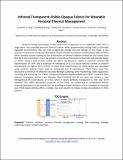| dc.contributor.author | Tong, Jonathan K. | |
| dc.contributor.author | Huang, Xiaopeng | |
| dc.contributor.author | Boriskina, Svetlana V | |
| dc.contributor.author | Loomis III, Robert James | |
| dc.contributor.author | Xu, Yanfei | |
| dc.contributor.author | Chen, Gang | |
| dc.date.accessioned | 2016-12-09T20:08:20Z | |
| dc.date.available | 2016-12-09T20:08:20Z | |
| dc.date.issued | 2015-05 | |
| dc.date.submitted | 2015-03 | |
| dc.identifier.issn | 2330-4022 | |
| dc.identifier.issn | 2330-4022 | |
| dc.identifier.uri | http://hdl.handle.net/1721.1/105786 | |
| dc.description.abstract | Personal cooling technologies locally control the temperature of an individual rather than a large space, thus, providing personal thermal comfort while supplementing cooling loads in thermally regulated environments. This can lead to significant energy and cost savings. In this study, a new approach to personal cooling was developed using an infrared-transparent visible-opaque fabric (ITVOF) that provides passive cooling via the transmission of thermal radiation emitted by the human body directly to the environment. Here, we present a conceptual framework to thermally and optically design an ITVOF. Using a heat transfer model, the fabric was found to require a minimum infrared (IR) transmittance of 0.644 and a maximum IR reflectance of 0.2 to ensure thermal comfort at ambient temperatures as high as 26.1 °C (79 °F). To meet these requirements, an ITVOF design was developed using synthetic polymer fibers with an intrinsically low IR absorptance. These fibers were then structured to minimize IR reflection via weak Rayleigh scattering while maintaining visible opaqueness via strong Mie scattering. For a fabric composed of parallel-aligned polyethylene fibers, numerical finite element simulations predict 1 μm diameter fibers bundled into 30 μm yarns can achieve a total hemispherical IR transmittance of 0.972, which is nearly perfectly transparent to mid- and far-IR radiation. The visible wavelength properties of the ITVOF are comparable to conventional textiles ensuring opaqueness to the human eye. By providing personal cooling in a form amenable to everyday use, ITVOF-based clothing offers a simple, low-cost solution to reduce energy consumption in HVAC systems | en_US |
| dc.language.iso | en_US | |
| dc.publisher | American Chemical Society (ACS) | en_US |
| dc.relation.isversionof | http://dx.doi.org/10.1021/acsphotonics.5b00140 | en_US |
| dc.rights | Article is made available in accordance with the publisher's policy and may be subject to US copyright law. Please refer to the publisher's site for terms of use. | en_US |
| dc.source | Prof. Gang Chen | en_US |
| dc.title | Infrared-Transparent Visible-Opaque Fabrics for Wearable Personal Thermal Management | en_US |
| dc.type | Article | en_US |
| dc.identifier.citation | Tong, Jonathan K., Xiaopeng Huang, Svetlana V. Boriskina, James Loomis, Yanfei Xu, and Gang Chen. "Infrared-Transparent Visible-Opaque Fabrics for Wearable Personal Thermal Management." ACS Photonics, 2015, 2 (6), pp 769-778. | en_US |
| dc.contributor.department | Massachusetts Institute of Technology. Department of Mechanical Engineering | en_US |
| dc.contributor.approver | Chen, Gang | en_US |
| dc.contributor.mitauthor | Tong, Jonathan K. | |
| dc.contributor.mitauthor | Huang, Xiaopeng | |
| dc.contributor.mitauthor | Boriskina, Svetlana V | |
| dc.contributor.mitauthor | Loomis III, Robert James | |
| dc.contributor.mitauthor | Xu, Yanfei | |
| dc.contributor.mitauthor | Chen, Gang | |
| dc.relation.journal | ACS Photonics | en_US |
| dc.eprint.version | Author's final manuscript | en_US |
| dc.type.uri | http://purl.org/eprint/type/JournalArticle | en_US |
| eprint.status | http://purl.org/eprint/status/PeerReviewed | en_US |
| dspace.orderedauthors | Tong, Jonathan K.; Huang, Xiaopeng; Boriskina, Svetlana V.; Loomis, James; Xu, Yanfei; Chen, Gang | en_US |
| dspace.embargo.terms | N | en_US |
| dc.identifier.orcid | https://orcid.org/0000-0002-3973-8067 | |
| dc.identifier.orcid | https://orcid.org/0000-0001-7151-7355 | |
| dc.identifier.orcid | https://orcid.org/0000-0003-4821-8220 | |
| dc.identifier.orcid | https://orcid.org/0000-0002-3968-8530 | |
| mit.license | PUBLISHER_POLICY | en_US |
